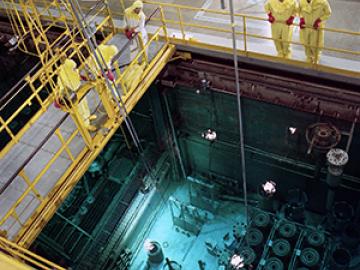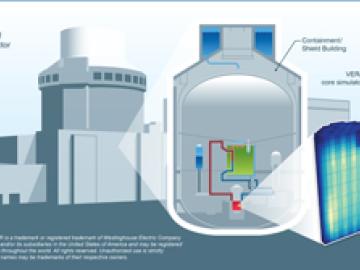Filter News
Area of Research
- (-) Computer Science (1)
- (-) Nuclear Science and Technology (5)
- Advanced Manufacturing (3)
- Biological Systems (3)
- Biology and Soft Matter (3)
- Building Technologies (3)
- Chemical and Engineering Materials (2)
- Chemistry and Physics at Interfaces (5)
- Clean Energy (19)
- Climate and Environmental Systems (4)
- Computational Biology (1)
- Computational Chemistry (4)
- Computational Engineering (1)
- Earth Sciences (1)
- Energy Frontier Research Centers (6)
- Fuel Cycle Science and Technology (1)
- Functional Materials for Energy (8)
- Geographic Information Science and Technology (1)
- Materials (31)
- Materials for Computing (7)
- Materials Synthesis from Atoms to Systems (8)
- Materials Under Extremes (5)
- Neutron Data Analysis and Visualization (2)
- Neutron Science (6)
- Nuclear Systems Technology (1)
- Quantum Condensed Matter (2)
- Renewable Energy (1)
- Sensors and Controls (1)
- Supercomputing (15)
- Transportation Systems (3)
Media Contacts

Blowing bubbles may be fun for kids, but for engineers, bubbles can disrupt fluid flow and damage metal.

The High Flux Isotope Reactor, or HFIR, now in its 48th year of providing neutrons for research and isotope production at the Department of Energy’s Oak Ridge National Laboratory, has been designated a Nuclear Historic Landmark by the American Nuclear Society (ANS).

Researchers at the Department of Energy’s Oak Ridge National Laboratory got a surprise when they built a highly ordered lattice by layering thin films containing lanthanum, strontium, oxygen and iron. Although each layer had an intrinsically nonpolar (symmetric) distribution of electrical charges, the lattice had an asymmetric distribution of charges. The charge asymmetry creates an extra “switch” that brings new functionalities to materials when “flipped” by external stimuli such as electric fields or mechanical strain. This makes polar materials useful for devices such as sensors and actuators.

A team representing Westinghouse Electric Company and the Consortium for Advanced Simulation of Light Water Reactors (CASL), a Department of Energy (DOE) Innovation Hub led by Oak Ridge National Laboratory (ORNL), has received an International Data Corporation HPC Innovation Excellence Award for applied simulation on Titan, the nation’s most powerful supercomputer, which is managed by the Oak Ridge Leadership Computing Facility at ORNL. s

Oak Ridge National Laboratory researcher John Wagner has been named a 2013 recipient of the Department of Energy’s Ernest Orlando Lawrence Award for his work in advancing computer, information and knowledge sciences.

Scientists and engineers developing more accurate approaches to analyzing nuclear power reactors have successfully tested a new suite of computer codes that closely model “neutronics” — the behavior of neutrons in a reactor core.




